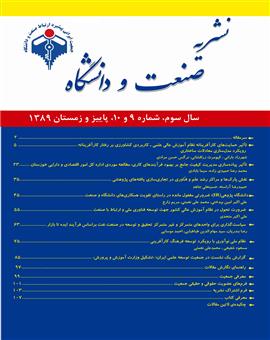سياستگذاري براي واحدهاي متمركز و غير متمركز تحقيق و توسعه در صنعت نفت براساس فرآيند ايده تا بازار
محورهای موضوعی :1 * , سيد مهام الدين طباطبایي 2 , احمد موسايي 3
1 -
2 - دانشگاه کارلتن کانادا
3 - پژوهشگاه صنعت نفت
کلید واژه: تحقيق و توسعه, ساختارهاي تحقيق و توسعه, واحدهاي تحقيق و توسعه متمركز 1 و غيرمتمركز2 در سازمانهای بزرگ, صنعت نفت, فرآيند ايده تا بازار,
چکیده مقاله :
امروزه تحقيق و توسعه به يكي از مهمترين اركان سازمانها تبديل شده است و صنعت نفت نيز به عنوان بزرگترين صنعت كشور از اين قاعده مستثني نيست. اما در خصوص ساختار و جايگاه تحقيق و توسعه در سازمانهارويكردها و ساختارهاي متنوع و متفاوتي وجود دارد. در سازمانهاي بزرگ سه نوع ساختار تحقيق و توسعه بيشتر مورد استفاده قرار گرفتهاند كه عبارتند از: • ساختار متمركز فعاليتهاي تحقيق و توسعه • ساختار غير متمركز فعاليتهاي تحقيق و توسعه • ساختار هيبريدي فعاليتهاي تحقيق و توسعه در اين مقاله ابتدا اركان فرايند ايده تا بازار تشريح شده، سپس انواع ساختارهاي تحقيق و توسعه در سازمانهاي بزرگ تعريف و جايگاه آن در صنعت نفت بررسي ميشود. در ادامه براساس اركان فرآيند ايده تا بازار به تشريح وظايف و ماهيت فعاليتهاي بخشهاي متمركز و غير متمركز تحقيق و توسعه در ساختارهاي هيبريدي تحقيق و توسعه پرداخته ميشود و درنهايت سياستهايي براي بهبود وضعيت تحقيق و توسعه در صنعت نفت ارائه میشود
Nowadays, R&D is the one of the most important pillars of corporations. Oil industry is the Iran's largest industry an as a corporation no except of this rule. But various structures and different approaches exist for the position of R&D in corporations' structure. Three major structures have been used more in corporations for research and development, which are: • Centralized R&D structure • Decentralized R&D structure • Hybrid R&D structure In this paper first, the stages of idea to market process will be described. Then the types of R&D structures in corporations will define and then their position in the Iran's oil industry investigated. Next according to the stages of idea to market process, duties and nature of activities in centralized and decentralized R&D sections in hybrid R&D structures will discuss. Finally some policies and recommendation for the improving the R&D in the Iran's oil industry is presented
. باقرينژاد، جعفر، رويكرد سيستمي به كيفيت در آموزش عالي در چارچوب نظام نوآوري ملي، نشريه صنعت و دانشگاه، سال سوم شماره 7 و 8، صص 23 ـ 13، بهار و تابستان 1389.
2. كشاورز، محسن، رحيمي، محسن، سليمي مجيد، نقش مراكز تحقيق و توسعه در نظام نوآوري، نشريه صنعت و دانشگاه، سال سوم شماره 7 و 8، صص 45 ـ 35، بهار و تابستان 1389.
3. کييزا، ويتوريو، مترجم قاضي نوري، سپهر، مهديخاني، محبوبه، استراتژي و سازماندهي R and D، وزارت صنايع، مرکز صنايع نوين 1384.
4. هاوارد راش، مترجم طباطبایيان م، برنامهريزي استراتژيک مؤسسات تحقيق و تکنولوژي: رويکردي تطبيقي، مؤسسه آموزش و تحقيقاتي صنايع دفاعي 1379.
5. Bandarian, R. “Exploiting value chain process concepts in research organisations”, Int. J. Value Chain Management, Vol. 2, No. 3, pp. 400–416. 2008.
6. Bell, R. M. “Integrating R&D with industrial production and technical change: strengthening linkages and changing structures”', UNESCO Workshop on Integration of Science and Technology in Development Planning and Management Process, 1993.
7. Nath, P. , Visalakshi, S. “Strengthening Technological Capabilities in Developing Countries: Strategies and Issues”, Gyan Publishers, New Delhi, 1999.
8. Rush, H. , Hobday, M. , Bessant, J. , Arnold, E. “Strategies for best practice in research and technology institutes: an overview of a benchmarking exercise”, R&D Management, Vol. 25 No. 1, pp. 17 ـ 31, 1995.
9. Silverman, Brian S. and Argyres, Nicholas S. , “R&D, Organization Structure, and the Development of Corporate Technological Knowledge”. Strategic Management Journal Special Issue, 2004.
10. UNITED NATIONS, “Science, Technology and Innovation Policy Review The Islamic Republic of Iran”, United Nations Conference on Trade and Development, New York and Geneva, 2005.
11. WAITRO, “Strengthening research and technology organizations’ capabilities”, WAITRO, Copenhagen, 1996.

